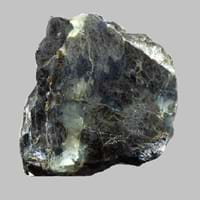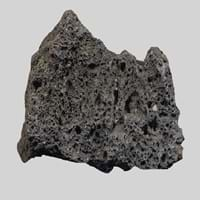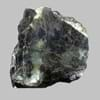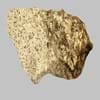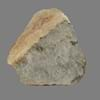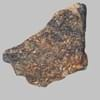Definition
Pyroxenite is a dark, greenish, granular intrusive igneous rock consisting mainly of pyroxenes and olivine
Scoria is a dark-colored extrusive igneous rock with abundant round bubble-like cavities
Discoverer
Unknown
Unknown
Etymology
From pyro- fire + Greek xenos stranger as the mineral group was new to igneous rocks
From late Middle English (denoting slag from molten metal), from Greek skōria refuse, from skōr dung
Class
Igneous Rocks
Igneous Rocks
Sub-Class
Durable Rock, Hard Rock
Durable Rock, Medium Hardness Rock
Other Categories
Coarse Grained Rock, Opaque Rock
Fine Grained Rock, Opaque Rock
Texture
Clastic, Granular, Phaneritic, Porphyritic
Vesicular
Color
Black to Grey, Bluish - Grey, Dark Greenish - Grey, Green, Light Greenish Grey
Black, Brown, Dark Grey to Black, Red
Durability
Durable
Durable
Scratch Resistant
Yes
Yes
Appearance
Layered, Banded, Veined and Shiny
Glassy and Vesicular
Interior Uses
Countertops, Decorative Aggregates, Interior Decoration, Kitchens
Decorative Aggregates, Interior Decoration
Exterior Uses
As Building Stone, As Facing Stone
Garden Decoration, Paving Stone
Other Architectural Uses
Curbing
Curbing
Construction Industry
As Dimension Stone, Building houses or walls, Cement Manufacture, Construction Aggregate, for Road Aggregate
Cement Manufacture, Construction Aggregate, for Road Aggregate, In landscaping and drainage works
Medical Industry
Not Yet Used
Not Yet Used
Antiquity Uses
Artifacts
Artifacts, Monuments, Sculpture
Commercial Uses
Cemetery Markers, Commemorative Tablets, Laboratory bench tops, Jewelry, Sea Defence, Tombstones
As a traction material on snow-covered roads, Creating Artwork, High-temperature insulation, In gas barbecue grills
Types
Clinopyroxenites, Orthopyroxenites and Websterites
Not Available
Features
Generally rough to touch, Host rock for Diamond, Is one of the oldest rock
Available in Lots of Colors and Patterns, Generally rough to touch, Surfaces are often shiny
Archaeological Significance
Monuments
Not Yet Used
Used
Famous Monuments
Not Applicable
Data Not Available
Sculpture
Not Yet Used
Used
Famous Sculptures
Not Applicable
Data Not Available
Pictographs
Not Used
Used
Petroglyphs
Not Used
Used
Figurines
Not Yet Used
Used
Formation
Pyroxenites are ultramafic igneous rocks which are made up of minerals of the pyroxene group, such as augite and diopside, hypersthene, bronzite or enstatite.
Scoria forms when magma containing huge amount of dissolved gas flows from a volcano during an eruption.
Mineral Content
Amphibole, Augite, Bronzite, Chromite, Diopside, Enstatite, Garnet, Hornblende, Hypersthene, Magnetite, Pyroxene
Apatite, Biotite, Calcite, Feldspar, Hematite, Hornblade, Ilmenite, Magnetite, Olivine, Pyroxene, Quartz, Silica
Compound Content
Aluminium Oxide, CaO, Chromium(III) Oxide, Iron(III) Oxide, Potassium Oxide, MgO, Sodium Oxide, Silicon Dioxide, Sulfur Trioxide
Ca, NaCl
Types of Metamorphism
Burial Metamorphism, Impact Metamorphism, Regional Metamorphism
Burial Metamorphism, Cataclastic Metamorphism, Contact Metamorphism
Types of Weathering
Biological Weathering, Chemical Weathering, Mechanical Weathering
Biological Weathering, Chemical Weathering, Mechanical Weathering
Types of Erosion
Chemical Erosion, Coastal Erosion, Water Erosion
Chemical Erosion, Coastal Erosion, Glacier Erosion
Grain Size
Coarse Grained
Fine Grained
Fracture
Uneven
Conchoidal
Streak
White, Greenish White or Grey
White
Porosity
Less Porous
Highly Porous
Luster
Dull to Vitreous to Submetallic
Subvitreous to Dull
Cleavage
Irregular
Perfect
Toughness
Not Available
2.1
Specific Gravity
3.2-3.5
Not Available
Transparency
Opaque
Opaque
Density
3.1-3.6 g/cm3
Not Available
Resistance
Impact Resistant, Pressure Resistant, Wear Resistant
Heat Resistant, Impact Resistant, Pressure Resistant, Wear Resistant
Deposits in Eastern Continents
Asia
India, Russia
Afghanistan, Indonesia, Japan, Russia
Africa
South Africa
Ethiopia, Kenya, Tanzania
Europe
Germany, Greece, Italy, Scotland, Turkey
Greece, Hungary, Iceland, Italy, Turkey
Others
Greenland
Not Yet Found
Deposits in Western Continents
North America
Canada, USA
Bahamas, Barbados, Canada, Costa Rica, Cuba, Jamaica, Mexico, USA
South America
Brazil, Colombia, Venezuela
Argentina, Chile, Ecuador, Peru
Deposits in Oceania Continent
Australia
New Zealand, Queensland
New Zealand, Western Australia
All about Pyroxenite and Scoria Properties
Know all about Pyroxenite and Scoria properties here. All properties of rocks are important as they define the type of rock and its application. Pyroxenite and Scoria belong to Igneous Rocks.Texture of Pyroxenite is Clastic, Granular, Phaneritic, Porphyritic whereas that of Scoria is Vesicular. Pyroxenite appears Layered, Banded, Veined and Shiny and Scoria appears Glassy and Vesicular. The luster of Pyroxenite is dull to vitreous to submetallic while that of Scoria is subvitreous to dull. Pyroxenite is available in black to grey, bluish - grey, dark greenish - grey, green, light greenish grey colors whereas Scoria is available in black, brown, dark grey to black, red colors. The commercial uses of Pyroxenite are cemetery markers, commemorative tablets, laboratory bench tops, jewelry, sea defence, tombstones and that of Scoria are as a traction material on snow-covered roads, creating artwork, high-temperature insulation, in gas barbecue grills.
